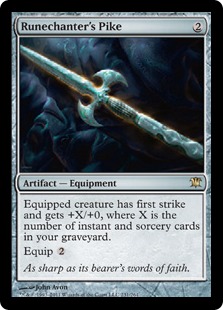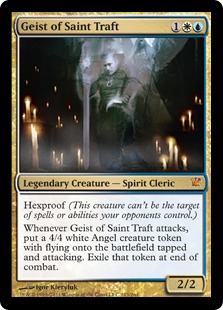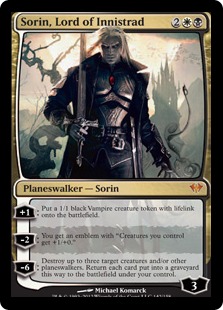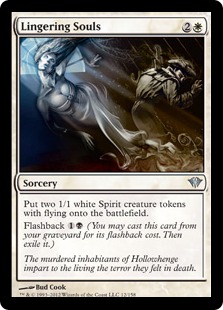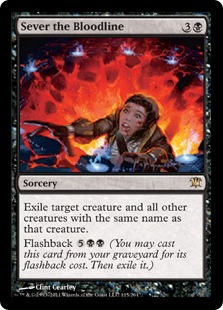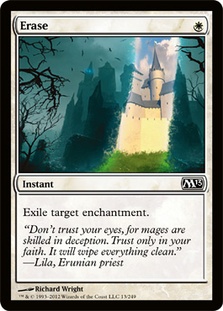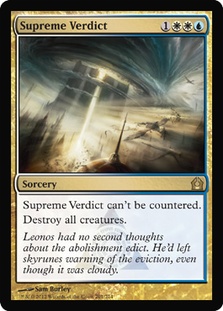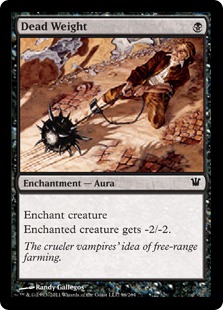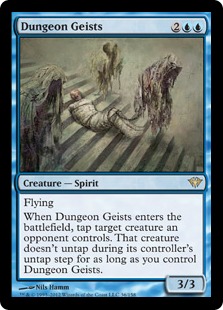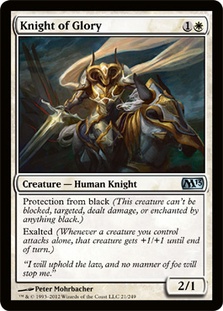Hello all! Welcome back! In this week’s installment, I’ll be talking about the new Esper tokens deck that I designed for Standard. Leading up to a Pro
Tour, I usually try to play as much tournament Magic as I possibly can in order to hone my skills and shake off the rust. Rather than simply test matchups
for Modern (and I did test!), I like to play other formats as well. With Return to Ravnica just released, and a brand new fresh format to brew for, I
simply couldn’t help but throw my own horse into the race!
My metagame solution: a fishy Esper deck that packs a one-two punch of efficient threats and potent permission magic. I piloted the deck in a local
35-player event at Warriors 3 Comics and Games last weekend and split the finals after going 4-1 in the Swiss. Having played with the deck and tuned it
after my first tournament, I believe it to be a solid tournament deck that could be a perfect choice for the SCG Standard Open in New Orleans.
Creatures (10)
Planeswalkers (3)
Lands (23)
Spells (24)
- 1 Dissipate
- 3 Syncopate
- 2 Think Twice
- 1 Negate
- 2 Forbidden Alchemy
- 2 Sever the Bloodline
- 3 Runechanter's Pike
- 4 Thought Scour
- 4 Lingering Souls
- 2 Azorius Charm
Sideboard

The catalyst for building this deck was a conversation I had with a friend where he asked me: “If you wanted to build a deck that beat Miracles every
single time, what would your deck look like?” Counters, card advantage, and resilient threats — usually that’s a good place to start.
This deck simply crushes tap-out, sweeper-based control decks.
You can stick a threat that is also a value card (Snapcaster, Lingering Souls, Augur, Restoration Angel) and protect it with permission. The control decks
in this format do not play their own threats early, but rather try to control the game with sweepers and Jace, Architect of Thought, eventually winning big
with an Entreat the Angels or similar spell. Sweepers are horrible against a deck that requires the opponent to waste a card to counter what is effectively
half a card.
“The last sword standing in Standard.”
Runechanter’s Pike is also a huge card against tap-out control — control decks do not like getting smacked in the face for six damage from a Spirit token!
Pike is also pretty outstanding when equipped to this fine fellow:
“The Ghost with the most.”
There are a lot of other interesting interactions built into this deck. One thing I discovered was that Sorin, Lord of Innistrad’s second ability (creating
an emblem providing +1/+0 to all of your creatures) is really good at nullifying Jace, Architect of Thought. By using this ability, it essentially offsets
Jace’s +1 Loyalty ability for the rest of the game, which is pretty amazing. Sorin is also a fixture in this deck because of his ability to provide an
endless stream of 1/1 lifelinking Vampires that are fantastic for chump-blocking.
“The anti-Jace.”
While the Vampire tokens are pretty modest on their own, when equipped with a Runechanter’s Pike they can easily dominate the game in many matchups. A 7/1
creature with first strike and lifelink is no joke.
When I initially built this deck, I was playing with Jace, Architect of Thought, and while I think the card is good, it was lackluster in an aggro/control
deck. I kept cutting Jace for more Sorin and more Runechanter’s Pike, which is ultimately the focal point of this deck.
The other interesting dimension of this deck is the graveyard package:
These cards are really the engine of the deck, as they allow the pilot to gain card advantage and additional options throughout the game. They make
Runechanter’s Pike completely ridiculous by stocking the graveyard with lots of instants and sorceries. In addition, these cards also provide a strong nut
draw of turn one Thought Scour, mill a Lingering Souls, and turn two flashback Lingering Souls.
Also, this avenue of the deck provides a lot of card advantage and card filtering for the deck. Forbidden Alchemy is a virtual Demonic Tutor that
allows you to see a lot of cards to find an important counter, removal spell, threat, etc. (not to mention the chance to bin Think Twice and Lingering
Souls!).
“Do you have to let it linger?”
Lingering Souls is, simply put, good value. It provides a plethora of chump blockers while you take to the skies with a Pike and win the game.
The rest of the deck is rounded out with other premier quality cards. Snapcaster Mage, Augur of Bolas, and Restoration Angel, all fantastic cards in their
own right, have tons of synergy with the rest of this deck.
“A card that cuts deep.”
Sever solves a few very specific problems. In particular, it is fantastic at wiping out Entreat the Angels tokens and mowing down regenerating and
recursive zombies. In addition, it can also easily deal with other powerful creatures that can’t simply be ignored by chump blocking, such Olivia Voldaren;
Niv-Mizzet, Dracogenius; and Angel of Serenity.
The last defining characteristic of this deck is that it gets to play with a lot of permission spells: 3 Syncopate, 1 Dissipate, and 1 Negate. Negate may
seem like a weird card, but in my experience it has been fantastic against almost every deck. Even in matchups like GW Beatdown, it still hits their
Rancors or Oblivion Rings.
“Say ‘no’ to Jace.”
I really wanted a card that could counter opposing Planeswalkers, Terminus, and Entreat the Angels. Negate was the card for me. Another thing that Negate
does well is protect our investments on the board. For instance, a Lingering Souls or Vampire token isn’t worth very much on its own, which is why we play
them. They don’t cost much, and are free and plentiful. However, there will be points in the game where they get equipped with a Pike and need to hold back
a Thragtusk or Zombie. When the opponent goes to Pillar of Flame your card that you have sunk a lot of mana into equipping, Negate stops their removal.
Keep in mind this is the worst-case scenario for the card against aggro decks where Negate isn’t the greatest card. Against a deck like Miracles, Negate is
an absolute backbreaker with no shortage of insane targets.
Now let’s talk about the sideboard a little bit, as some of the cards might seem a little bit unconventional.
“Rancor-not-anymore.”
There are no shortage of fantastic targets for Erase in the current Standard: Detention Sphere, Oblivion Ring, Curse of Death’s Hold (which is the best
possible card against us), Rancor, Rest in Peace (also great against us), and the list goes on. I usually don’t like to play with really, really narrow
cards, or cards that are inherently not powerful, but given the state of the format I actually believe that playing with sideboard Erase is simply
necessary. It has been absolutely fantastic and game-changing every time I’ve drawn it. When you can make an endless stream of 1/1 tokens against a
Thragtusk, the question becomes: does it have Rancor or not?
Rancor is really good against token blockers and Sorin in particular. It is well worth playing with a card to get rid of Rancor for good.
“Tried and true.”
Duress as a major trump in the blue mirror is a battle that has been fought throughout the ages. It is obviously fantastic under those conditions: take a
peek at their hand and take their best or most important tactic. Against the decks that don’t play creatures or attack, it is, simply put, the best
possible card outside of the Negates the deck already has. Being able to flash it back with Snapcaster makes the card even better than usual.
Other blue decks don’t stand a chance!
“Guilty.”
Supreme Verdict is a pretty obvious card against GW decks and other beatdown strategies where clearing the board is essential. Having access to Supreme
Verdict is worthwhile, especially in a deck that gets to see a lot of cards like this one.
“Ironically, ‘dead’ is good against Zombies.”
Dead Weight has really impressed me so far, and it is a card I am open to playing more after sideboard. Dryad Militant; Thalia, Guardian of Thraben;
Diregraf Ghoul; Deathrite Shaman–the list goes on and on of good targets that I would gladly trade a mana and a card to kill on turn two.
It is also really good against Lotleth Troll, as the enchantment either kills it or shrinks it down to a manageable size.
“Welcome to ghost jail.”
Geists are specifically for dealing with Rancor and Thragtusk. I wasn’t sure about this card at first, as it is a pretty big investment, but it has really
impressed me thus far. One obnoxious point about Standard is that there are very few ways to deal with a Thragtusk that don’t put you way behind. Geist is
one of the few cards that not only doesn’t lose value to the tusk, but actually answers it for value (provided they can’t kill it). This tells me that
Dungeon Geists could be a big player moving forward.
“Obviously for the mono-red match up.”
Knight is outstanding at fighting Zombies and punches through a lot of damage in a hurry. One on offense and one on defense is a really strong position to
end up in. I haven’t really seen a plan other than this that seems better to me than simply boarding Knights. If one exists or comes to fruition, replace
the Knights, but until then it’s Knight-time.
That’s the deck. Not only did it perform really well for me, but it was really fun to play with, as it provides a lot of room for making plays and having
interesting options available. Give it a try! It’s pretty sick.
If you don’t actually end up playing with the deck, here are a few things to keep in mind:
Thought Scour + Snapcaster Mage is, in my opinion, the only way to play Snappyboy.
Runechanter’s Pike is no joke. It is good against everybody.
Sorin, Lord of Innistrad may be the best Planeswalker in Standard.
Cheers, and thanks for reading,

